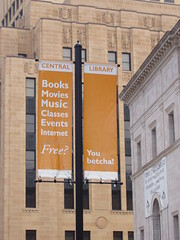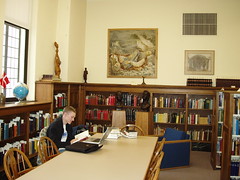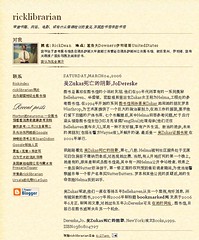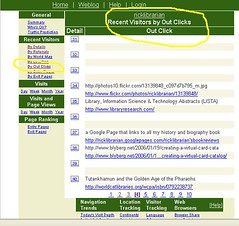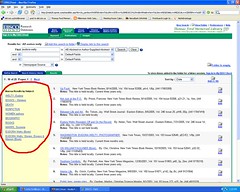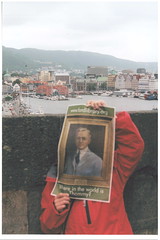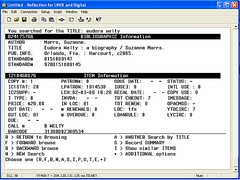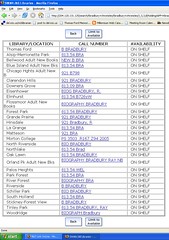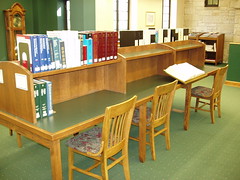Friday, March 31, 2006
Slaves in the Family by Edward Ball
Edward Ball is a descendant of the Ball family of Charleston, South Carolina, a family that lived in the city in its early colonial days. Being prominent and landed, the Balls owned slaves - hundreds of them. They also married into families that shipped slaves from Africa and sold them in slave auctions in the city. It is an ancestory that the author regrets. After doing family and historical research, Ball began tracking down and meeting some of the descendants of his family's slaves. While not all were glad to meet him, some pulled out all their old pictures and Bibles and told family stories. The author learned more than he expected.
Though Slaves in the Family is a big book, 504 pages, it is hard to put down. You may read it quickly. I highly recommend it.
Ball, Edward. Slaves in the Family. New York: Farrar, Straus and Giroux, 1998. ISBN 0374265828
Wednesday, March 29, 2006
You Betcha!
Thoughts on Computers in Libraries 2006
I enjoyed following the conference by visiting the many blogs. You can still do so. One easy way to find reports is go to technorati and enter cil2006 as your search term.
I just found another helpful post, this time by Jill Hurst-Wahl. Librarians working on digital archives using donated materials (old photos, documents, etc.) will want to look at her deed of gift forms.
I thought I might link my readers to more of the reports from the conference, but I found so many of them filled with jargon and acronyms. They are probably fine for IT professionals, but I am sometimes unable to sort out their meanings for my library and the profession. For example, I noticed several reports on FRBR, which seems to be important to future online library catalogs. I have read the definitions, but I am still fuzzy on what it is. If it will improve access to library materials, I am for it.
Writers of library technical blogs, your less technical colleagues are also trying to read your work. Please consider them in your writing. It will advance librarianship and perhaps give you more influence in your home libraries if you do.
Other postings on the conferences:
Conference Reports of March 22
Conference Reports of March 23
Conference Reports of March 24
Tuesday, March 28, 2006
Kierkegaard Library at St. Olaf College
Monday, March 27, 2006
Shelflist in the Main Library at the University of Iowa
Click the photo to find more photos from the University of Iowa, a stop on my daughter's spring break college tour.
Vietnam: One Week's Dead, May 28 - June 3, 1969
I had not used the old Readers' Guide to Periodical Literature recently, so I had not had to struggle with its subjects and sub-headings. I pulled volumes 28 (March 1968 - February 1969) and 29 (March 1969 - February 1970) off the shelf and went to the V section of volume 29, where I found "Vietnamese war, 1957 -," which is a more honest subject heading than "Vietnamese Conflict" used by Library of Congress Subject Headings then and now. Under the subject I found all these subheadings:
- Aerial operations
- American participation
- American troop withdrawals
- Anecdotes, facetiae, satire, etc.
- Atrocities
- Atrocities - Songmy massacre
- Bibliography
- Campaigns and battles
- Casualties
- Costs
- Damage to property see Vietnamese war - Destruction and pillage
- Destruction and pillage
- Economic aspects
- Equipment and supplies
- Foreign participation
- Guerrillas
- Heroes
- Legal aspects
- Medical and sanitary affairs
- Moral and religious aspects
- Moving pictures see Moving pictures - War films
- Negroes
- Pacification programs
- Peace and meditation
- Peace and meditation - Negotiation meetings, May 1968 -
- Peace and meditation - Negotiation meetings, May 1968 - Anecdotes, facetiae, satires, etc.
- Personal narratives
- Photography
- Poetry
- Press reports and censorship
- Prisoners and prisons
- Propaganda
- Protests, demonstrations, etc. against
- Protests, demonstrations, etc. against - Marches on Washington, November 1969
- Protests, demonstrations, etc. against - Moratorium day, October 15, 1969
- Protests, demonstrations, etc. against - Moratoriums, rallies, etc., November 1969
- Protests, demonstrations, etc. against - Moratoriums, rallies, etc., December 1969
- Psychological aspects
- Public opinion
- Relief work
- Social aspects
- Strategy
- Television reports see Television broadcasting - War news
- War alms
- Women and the war
Under each subheading was any number of citations to magazine articles. "Heroes," "Photography," and "Relief work" only had one citation each. "Guerrillas" and "Propaganda" had only two each. "Atrocities - Songmy massacre," which refers to the My Lai massacre, had 39 citations. "American participation" had the most, more than a page in tiny print. Under each subheading the citations were listed alphabetically by the article title.
Looking at the pages of tiny print, I really hoped the client had the title right. I looked at "Casualties" first, but no articles started with the word "One." I scanned for "One" under the other sub-headings without luck. Then I came back to "Casualties" and read each entry, looking for an item from Life. I found it near the end:
Vietnam one week's dead: May 28-June 3.
1969: a record and a tribute. il Life 66:20-
32 Je 27 '69
Then I took microfiche to our reader/printer and found the article with all the photographs. I was struck how young the soldiers looked. For many, Life had used their senior pictures from their high school yearbooks. Many seem to look right at you.
While the process seemed antiquated, I actually found what I wanted within three minutes with reference desk interruptions. I used to use the Readers' Guide constantly, and I easily moved back into the needed mindset. It has shortcomings, but it does still cite the literature of its day in some useful groupings. If I wanted to study the economic effects of the war, I would find a collection of selected articles on the topic together. Long ago an H. W. Wilson Company indexer put them all together for readers. It was the best service of its day for the public library researcher.
People say I am pretty good with database searching. I think I am because I was good with the tools that we used to use before we were online. There may still be value in teaching fundamental searching concepts by using the old tools, getting deep into pages full of citations that have to be visually sorted. Results did not just appear on a screen. Will learning the old tools be an option long? Who will retain old tools when budgets and space are strained?
Sunday, March 26, 2006
New Edition of Joy of Cooking
A lengthy account of the country's culinary vocabulary deficit can be found in "Boiling It Down for Cooking-Challenged" by Candy Sagan in the Chicago Tribune, March 22, 2006, Section 1, page 10. The same article was in the Washington Post on March 18 as "Cooking 101: Add 1 Cup of Simplicity."
Neither Baker & Taylor nor Amazon yet have information on the new edition of The Joy of Cooking. The website for Sharles Scribner's Sons also has no information that I can find.
Garner by Kirstin Allio
I enjoyed the first novel Garner by Kirstin Allio. It was a bit of a puzzle to read, as the author seemed reluctant to pin down the story, but solving the mystery is half the fun. The other half was reading Allio's description of the woods, the community, and the people.
So, who knows the truth? Is it the postman, who seems to know the contents of every letter? Is it his wife who talks with all the neighbors and follows her husband on a walk in the woods on an eventful evening? Is it one of the city people staying the Giddens farm? You will not know until you read the end.
Allio, Kirstin. Garner. Minneapolis: Coffehouse Press, 2005. ISBN 1566891752
Saturday, March 25, 2006
An Immigrant Class: Oral Histories from Chicago's Newest Immigrants by Jeff Libman
What the reader quickly discover is that the political arguments over immigration mistakenly portray immigrants as one like-minded body of people. In truth, the United States attracts people from many countries for many reasons. People from 144 countries have taken ESL classes at his college, according to the author. For many coming to the United States was not their dream. Many tried to lead good lives in their native lands, but political, environmental, or economic conditions drove them out.
Some worked hard to come to the country legally, while others worked to gain legal status after coming. All live in the U.S. with a mixture of hope and fear. While their skills and contributions to the U.S. economy vary, most work hard, pay taxes, and break no laws other than immigration laws.
Each story could be a feature piece is a newspaper or magazine. Many of the immigrants have endured great hardships and suffered great tragedies. They all have an appreciation for freedoms that many native Americans take for granted.
My library bought its copy of the book directly from the author. Go to his An Immigrant Class website for ordering instruction. You will also find a calender of the the author's speaking engagements. We plan to have him at the Thomas Ford Library next winter.
Libman, Jeff. An Immigrant Class: Oral Histories from Chicago's Newest Immigrants. Chicago: Flying Kite, Inc., 2004. ISBN 0974142905
Dear Wendy
As I watched the movie, I wondered whether anyone would have anything to say. I should not have worried. As the credits started rolling, so did the questions and observations. Where was the movie set? It could have been any coal town in America, and the clues were ambiguous. The time was also unspecified. No one had a cellphone. No one had a home computer. The main character played Zombies' records that he had rediscovered. So was it the 1970s? With the antique weapons and costumes, it was in a way all time American. The evidence of American fanaticism came from many eras.
While the film was about America, it was not an American production. It was filmed in Denmark and Germany by two of Denmark's Dogme 95 filmmakers. They did not stick to the Dogme 95 creed. With violence and background music, it was a sensational film, very un-Dogme on the surface. Still, there was an economy of story that was very effective.
Was it a good movie? Nine out of ten of our viewers seemed to give it a thumbs up. Even the viewer who said he hated it admitted that it was very well done. I would agree.
Friday, March 24, 2006
Conference Reports of March 24, 2006
Andrea Hull, a library student at UCLA, took notes on a program Library Wi-Fi 2006. The first half of the report serves as a good introduction, with some updated information about standards.
Jenica of Thinking Out Loud has a report of a Computers in Libraries presentation The Internet: Enhancing Digital Work and Play, which seems to focus on the expectations of Millenials and how they will seek information.
Back at PLA, Adrienne Furness attended Jon Scieszka's program Guys Read. Her report is short but it gives the clues you need for more research into the topic.
PLA had an interesting presentation by Joe Raiola of Mad Magazine. In the report by Jessamyn West, you learn how Mad skirted the censors and became a magazine instead of a comic book.
Beth Gallaway attended an interesting presentation by David Liroff of WGBH public television Technologial Drivers of Change for the Rest of Us. In her report are many fascinating facts and speculations. Did you know that WGBH started as a public lecture series in the 1830s? Liroff talks a lot about changes in TV and delivery of programming via the web.
Reports from the Conferences, March 23
Sarah was also presenter with Laurie Thompson of Creating a Digital Library on a Shoestring. Jessamyn West wrote a report on the PLA Blog. It looks like time and staff are the key ingredients to success.
Beth Gallaway reports on the PLA Blog about Denver Public Library's Wake Up Call to study its demographics and customer service implications. Four members of the DPL staff described their study and implementation of findings.
If seeing photos would give you more of a feel of being there, click here.
Thursday, March 23, 2006
A Really Good Library Story from Feel-good Librarian
Wednesday, March 22, 2006
Update on Conferences for March 22, 2006
Beth Gallaway attended the PLA Opening session (though she was in an adjoining room unable to actually see the stage) to hear Linda Ellerbee's keynote speech. Here is a link to her report on the PLA Blog. Beware, she used a very small font. You may want to increase the font size.
Nicole C. Engard wrote a readable report on the keynote presentation by Chris Sherman of Search Engine Watch at Computers in Libraries. Of course, the presentation was mostly about search engines. For another view and more details, go to David Lee King's report in bullets. Aaron Schmidt did not write a full report, but did comment on the presentation.
Meredith Farkas attended Building Community with IM at the Computers in Libraries Conference. Click here for her report on what Amanda Etches-Johnson, Aaron Schmidt, and Michael Stephens said about using instant messaging in libraries.
Two Conferences Start Today
Here are links to what I will be reading:
PLA blog
Walking Paper - Aaron Schmidt is speaking at both conferences.
CIL Conference Bloggers - There are more blogs than I can possibly read here.
Several of the bloggers I read are at PLA. There does not seem to be a PLA blogging list, but I will see them through Bloglines.
Next week, I will be on a road trip with my daughter Laura looking at colleges in Iowa and Minnesota. I hope to be able to post a couple of items from the trip. I am sure there will be photos.
April is National Poetry Month. I am counting on you to read some poetry. It will be a nice change of pace after reading many conference reports.
Tuesday, March 21, 2006
The Trouble with Poetry and Other Poems by Billy Collins
I was very glad to get my hands on his latest collection, The Trouble with Poetry and Other Poems. In it are 43 lively poems, most of which are one or two pages long. The collection begins with an engaging poem "You, Reader," in which the poet speaks directly to us, teasing us:
I wonder how you are going to feel
when you find out
that I wrote this instead of you
that it was I who got up early
to sit in the kitchen
and mention with a pen
the rain soaked windows,
the ivy wallpaper,
and the goldfish circling in its bowl.
Collins poems are often reactions to what he has seen, heard, or read. Upon learning that each Gutenberg Bible required 300 sheepskins, he wrote "Flock," in which all 300 sheep are penned together behind the house with the printing press. He wonders which ram or ewe will get to carry the news "The Lord is my shepherd."
Waking up in a house built in 1862, he wrote "House," a poem about all the people who had lived there, imagining what they did in each room. It is kind of spooky.
I laughed aloud while reading "Special Glasses," a spiteful poem, filled with scorn of some one:
but instead of filtering out the harmful
rays of the sun,
they filter out the harmful sight of you -
you on the approach,
you waiting at my bus stop,
you, face in the evening window.
I also like "See No Evil," "Class Picture, 1954," "Flying Notebook," and many other poems in the collection. You might, too. April is National Poetry Month. If you read only one poetry book during that month, The Trouble with Poetry would be a good choice. Reserve it now.
Collins, Billy. The Trouble with Poetry and Other Poems. New York: Random House 2005. ISBN 037550382x
Monday, March 20, 2006
ALA 2006 New Orleans Wiki
I found Stories from New Orleans through the wiki. I intend to read these stories from librarians as they are posted to keep up-to-date with conditions in the city.
Even if you are unable to attend the conference this summer, visit the wiki now and then. There will be many links to reports on the meetings and presentations from attendees. There will be so much more than you will find in the print journals.
Why New Orleans Matters by Tom Piazza
In the half of the book about New Orleans before the storm, Piazza describes the music, cuisine, architecture, and culture of the city. He advises readers to get away from the Bourbon Street area, which he maintains is not the real New Orleans. He also recommends renting a bicycle to explore the historic neighborhoods. Away from the tourist traps the visitor can discover wonderful people, like the gas station attendant who glued the frame of his broken glasses frame with fingernail-repair glue at 3:00 a.m.
The people of the city are Piazza's prime concern. Why New Orleans Matters should be read by government officials deciding the city's future.
Piazza, Tom. Why New Orleans Matters. New York: ReganBooks, 2005. ISBN 0061124839
Saturday, March 18, 2006
Ricklibrarian in Chinese Translation
Children of the Sun: A History of Humanity's Unappeasable Appetite for Energy by Alfred W. Crosby
The future is as important as the past in this book. Crosby says that our harvesting of petroleum is at its peak and will be downhill from now until eternity. We have to develop new energy resources soon. He likes wind and solar energies for environmental reasons, but says that they are local and not global solutions. Despite their problems, he thinks we have to expand our use of nuclear technologies. He argues that the alternative is to return to a 1750 A.D. model of energy use, a bad choice which would require many of us to die.
Crosby is a historian, not a scientist, and he writes for non-scientists. He includes just enough technical detail and a little humor to advance the story. I think he has succeeded in making a complicated history clear, and I understand steam engines and nuclear fusion better than before I read the book. I recommend this book to all public libraries and readers of history.
Crosby, Alfred W. Children of the Sun: A History of Humanity's Unappeasable Appetite for Energy. New York: Norton, 2006. ISBN 0393059359
Thursday, March 16, 2006
Metro News from the Metropolitan Library System Hidden from the World at Large
The most interesting story is "Stephanie Kirchner - Someone You Should Know." In this article she tells about her experiences volunteering in Louisiana and Mississippi after Hurricane Katrina. She notes that librarians are frontline relief workers in many of the communities. It is a nice article. You can not find it through Google the way it is now presented.
Kathryn J. Deiss has a piece on the future of libraries on page 4. Is this only for MLS librarians? Is that why it is screened from the world at large?
The second part of a report on how to libraries should monitor the electronic communications of their staffs is also in this newsletter. If it were also posted on the MLS website, it could spark a conversation. I know I take exception to the way the authors assume there are lots of library employees ready to spend all their work time on personal pursuits. (Part 1 in the February issue was the worst part.) Treat employees with respect and you won't need all these legalities. More rules do not make better work.
The Metropolitan Library System tends to be like the American Library Association in that it wants to keep some of its news behind barriers. Knock down that wall, MLS. Post these articles in a findable place. The world and MLS may benefit.
Harry Potter and the Half-Blood Prince by J. K. Rowling
I am sure we all have questions going into the final book. Can Harry really not return to Hogwarts? How can he not take Ron and Hermione with him? How will Harry find the horcruxes? How many enemies will he have to face? Will Rowling introduce a new character R. A. B.? How will friendship and love support Harry? Can Harry go through all of these trials and stay lovable?
I would not be surprised if writing book seven takes the author a little longer than some of the others. Imagine the security she will have to protect against leaking the story before publishing day. Imagine the last round of Harry Potter parties. It should be big.
Rowling, J. K. Harry Potter and the Half-Blood Prince. New York: Arthur A. Levine Books, 2005. ISBN 0439784549
Wednesday, March 15, 2006
Einstein on Libraries
Change in libraries has come relatively quickly in the past decade since most have been online with the Internet. Is the force for change coming from within libraries or are they being pulled by gravitational forces? Better libraies are plotting their own trajectories.
Don't get pulled into a black hole! Start plotting.
Site Meter Out Clicks
Tuesday, March 14, 2006
Paul Bausch Speaks about Web 2.0
So much has been written under the heading of web 2.0 that it is easy to quit paying attention. Bausch got to the heart of the matter and was entertaining to boot. Ancient Greeks, Copernicus, and Ranganathan were brought into the discussion. This report can serve as a good introduction to the topic of evolving change in the way people use the World Wide Web.
Watch the LITA Blog in the coming months. In its first year it has mostly reported conferences, but a team of bloggers is gearing up to report on technology in libraries on a more regular schedule.
Poetry Month is Coming
With a couple of weeks until April, you have time to read some poetry and plan some promotions for your library. Even if you are not a regular poetry reader, I think you will find the poets that I recommend readable. Try something new.
Monday, March 13, 2006
Google Page for History and Biography Book Reviews
A library or librarian needing to make a special page that does not work well within the constraints of its regular website might consider making a Google Page. It's free and fairly easy.
Sunday, March 12, 2006
EBSCO Results Enhanced with Clustering
Click here to see my review of the North Carolina State catalog. I also reviewed Clusty last year.
Saturday, March 11, 2006
The Summer of Ordinary Ways by Nicole Lea Helget
The rural world that Helget describes is filled with cruelty and lawlessness. Old men make moonshine and offer it to young girls. Grandmothers regret granddaughters for not being grandsons. Mothers whose children die in accidents are told, "Get over it! You can have more." Many animals die. The Helget and the Haalas families feud. There is even a story of premature burial as horrifying as the story by Edgar Allan Poe.
Throughout the book Helget has a keen sense of the land. She describes the sunlight, the wind, the spread of cottonwood seeds, the plowing of fields, and the transformation of paths into highways. Her family becomes a part of the landscape, from which escape becomes necessary.
The Summer of Ordinary Ways is a symmetrically balanced book. The final story is as disturbing as the first. You will have to read it to see what I mean.
Helget, Nicole Lea. The Summer of Ordinary Ways: A Memoir. St. Paul: Borealis Books, 2005. ISBN 0873515439
Thursday, March 09, 2006
"Teen admits quilt in car crash"
Wednesday, March 08, 2006
Thommy Ford on Top of Rosenkrantz Castle
Very New Orleans: A Celebration of History, Culture, and Cajun Country Charm by Diana Hollingsworth Gessler
Very New Orleans is a very attractive book filled with drawings and watercolor sketches of all things "Nola." On page 17, which introduces the reader to James John Audubon, she has sketched the double doors with green shutters to Audubon Cottage #1 and added three yellow orange and black Louisiana tanagers. On page 42, she has drawn Germaine Wells in her Mardi Gras costume as seen in the museum in Arnaud's restaurant. She has also depicted the floor tiles in four of the thirteen rooms of the famous restaurant. On page 55, she has drawn different boats one might see on the Mississippi River. Every page in book is colorful and worth consideration.
I am attending the American Library Association annual conference in New Orleans this June. I see in Very New Orleans several sites I want to see in the French Quarter, in the Warehouse Arts District, and about the city. I can probably walk from my hotel near the convention center to many of them, but I also hope the streetcars are running. Look for me at Faulkner House Books or the Garden District Book Shop. Anne Rice once arrived at the latter in a coffin. If I am not in a book store (or at the conference), look for me Lupo Salvatore eating a muffuletta or at Hansen's having a nectar with cream sno-ball. It should be an interesting trip.
Gessler, Diana Hollingsworth. Very New Orleans: A Celebration of History, Culture, and Cajun Charm. Chapel Hill: Algonquin Books of Chapel Hill, 2006. ISBN 1565124472
Tuesday, March 07, 2006
Item Record for Eudora Welty by Suzanne Marrs
I looked through the SWAN records and found that in this probably isolated case (maybe not) our medium small library has topped the bigger libraries in loaning a title. No other library has lent this book more than five times. Here's what I make of this.
1. Small libraries can do big things. Maybe not as many big things as big libraries, but we matter. Every day we can do something just as well.
2. Small libraries especially need to be friendly. We may be harder to notice, so we have to work a little harder and never turn anyone off with restrictive policies. Being friendly with other libraries counts, too. We will often loan new items to other libraries fairly soon, which may be included in our count in this case.
3. Publishers need not worry that they are losing sales to free reading at libraries. We are not moving books like music downloads on the Internet.
4. I would like to see these books moving more at all the libraries. I had assumed books were moving faster at the big libraries, but it is not so. We all need to do more to market the books we buy. We can not rest on the assumption that our books will sell themselves.
5. We win more support every time we find a book for one of our readers. We are our own best marketing tool. Maybe we should carry books wherever we go and never be seen without one.
All this from one little circ stat? What do you think?
Monday, March 06, 2006
Disappointing Circulation of The Bradbury Chronicles
Surprised that no one is currently reading the book, I wondered how many people had read it since April 2005 when the book was published. Relatively few is what I found. The 29 copies have been borrowed a total of 72 times, about 2.5 circs per copy. In one library the book had been out 8 times, in another 6, and in a couple of others 5. In four libraries, the copies have never gone out.
It is not easy predicting what our readers will like. We rely on book reviews and on our sense of our public's tastes. The book reviews gave the book high recommendations. We also do not want to reduce our collections to only popular items, and it is totally appropriate to get some books that will not "fly of the shelves." Still, I would have thought there would be more borrowing of The Bradbury Chronicles by old Bradbury fans.
We will make some miscalculations, but we should learn from them and not go out of our way to make more. I noticed that five libraries are now buying the paperback, four of which own the hardback. I wonder if any of them thought to look at how the hardcover circulated. I think we have enough copies in system to share already.
In a time when many of us have insufficient book money, we need to buy judiciously and share.
Saturday, March 04, 2006
Wimbledon Green: The Greatest Comic Book Collector in the World
Though I read plenty of comic books as a child, I have not been attracted to many of the recent graphic novels, but I like Wimbledon Green by Seth. It is a cleverly told story, adapting a documentary technique. Comic collectors and dealers tell us what they know of Wimbledon Green, and we have to decide which of them to believe. Green himself tells us several tales about his collecting adventures, which are at times a bit too fantastic to be believed.
In Wimbledon Green, collecting comic books is not child's play. The community of collectors is unkind at times. The collectors are obsessed, greedy, ruthless. "Why are they so opposite their virtuous comic book heroes?" one collector asks.
I like how the cover of the book reflects some past era. It looks like something I would have found at my grandmother's house. I recommend it to mature comic readers.
Seth. Wimbledon Green: The Greatest Comic Book Collector in the World. Montreal: Drawn and Quarterly, 2005. ISBN 1896597939
The Changing Role of the Index Table
Miss Zukas in Death's Shadow by Jo Dereske
I just finished reading Miss Zukas in Death's Shadow, the seventh of the eight books. Helma is sentenced to community service at a homeless shelter after refusing to pay the fine for a traffic violation that she contests. Of course, someone is shot to death the first night she is there, and it turns out to be the new member of the library board, the one with whom Helma had a public argument about censorship. Among the clues is a crushed bag of Nutter Butter cookies. First amendment rights are violated during the investigation, as the local supermarket gives the police a list of every customer who bought Nutter Butters. Ruth and other citizens are subsequently questioned, and Helma risks her life to find the killer.
Miss Zukas fans, who have been waiting five years for another case from Bellehaven, have good news. All the books are being republished in 2006 and 2007 and a new title Bookmarked to Die is being published in June 2006. The news and an article by Jo Dereske about her last five years can be found at her website. Libraries that missed getting the books before now have another chance.
Dereske, Jo. Miss Zukas in Death's Shadow. New York: Avon Books, 1999. ISBN 0380804727
Friday, March 03, 2006
Morton's Neuroma: A Librarian Looks at Consumer Health Reference Sources
Oh! My left foot! Sometime before Thanksgiving, it began to hurt. When I took my first step of the day, a shot of pain came from my bare foot as it touched our bedroom's hardwood floor. Examining it, I found a little swelling on the bottom of my foot between the third and fourth toes. I assumed I had a bruise and tried to ignore the discomfort. I hardly noticed anything once I had slippers or shoes on. After a few days I did not notice the pain again.
The pain returned a few days before Christmas. The swelling was greater, as was the pain, and standing in the shower was excruciating. I went to see my general practitioner. He guessed that I had a small fracture that would heal itself and he sent me to the hospital for x-rays. A few days later he called to say the x-rays did not show any fractures or tumors. Since my foot still hurt, he recommended several podiatrists, one of which was located only three blocks from my home. I got an appointment for a week later. I also got a copy of the x-ray report, which concluded "unremarkable left foot."
By the day of my appointment, my condition had greatly improved, but there was still something strange. It felt as though I had a seed or a bubble in my foot, something that at times popped slightly, and the pain returned if I had to walk far on sidewalks or around the supermarket (which seems to have a really hard floor). On bad days I mostly sat at the reference desk, using the Internet more than the reference books to help clients. Better was not well.
My trip to the podiatrist was unlike any appointment I have had in recent times. I arrived twenty minutes before the appointment as recommended to do first visit paperwork. I was in an examining room fifteen minutes before my set time. Within minutes I saw the doctor, and I left the building before my appointment time.
The podiatrist listened to my story, examined my foot, and diagnosed a common Morton's neuroma, a benign inflammation of nerves. He said that there are two nerves that cross right below a bone in the foot. The inflammation might go away on its own, but if it did not, it could be treated with an injection of corticosteroids or by surgery. In the meantime, if needed, I could take ibuprofen to lessen the pain and wear inserts in my shoe (which I had already discovered). He wrote "Morton's Neuroma" on a slip of paper, and I began my research.
A good question is why I did not research the topic on my own before the visit. You would think that a reference librarian would. Anne Kozak (head of the Thomas Ford Memorial Library) suggested Morton's neuroma to me when I was sure I had a fracture. Having the condition herself, she recognized the symptoms. ( I checked Library, Information Science & Technology Abstracts (LISTA) to see if there is a library epidemic, but there is none.) So, would I have recognized the condition from an examination of the reference sources? What now follows is what I have found.
Reference Books
American Medical Association Family Medical Guide, 4th edition - I found the term in the index. The entry that I found (on page 981 under the heading "Pain in the Front of the Foot") is very short, made up of one paragraph and a bullet list. It says most cases of Morton’s neuroma occur on top of the foot, but the condition can also affect the ball of the foot. My case is on the ball. It recommends going barefoot, which is contrary to my experience and my doctor’s advice. Wearing slippers or shoes helps me. The last suggestion is padding the tender spot.
Gale Encyclopedia of Medicine, 2nd edition - No information.
Professional Guide to Diseases, 8th edition - I found the term in the index, which led me to a one sentence definition in section on rare diseases.
Mayo Clinic Family Health Book, 3rd ed. - I found the term in the index. The entry starting on page 969 includes four short paragraphs. The description of burning pain true. I am advised to wear sandals or well-fitting shoes; adding inserts may also help. Steroid injections or surgery might help in extreme cases, according to this source.
Outline of Orthopaedics, 13th ed. – I found Morton's metatarsalgia in the index. Keep a medical dictionary handy if you use this book. It explains that a neuroma is a fibrous thickening. The usual patient is described as a middle aged woman. I recognize the “clicking” in the foot and agree with the desire to remove my shoe and manipulate the spot from which the pain radiates. It recommends padding in shoes as the first treatment and surgery if necessary.
Merck Manual of Medical Information, 2nd Home ed. - The term is in the index. "Pain Caused by Damage to the Nerves in the Ball" on page 403 describes a mild ache.
"A person may also feel as if a marble or pebble were inside the ball of the foot." That captures the feeling pretty well. The Merck says a local anesthetic is included in the corticosteroid shot.
Complete Guide to Symptoms, Illness & Surgery, 4th ed. - This work says little about the condition, but it does describe surgery from the bottom of the foot. It says that I wouldn't be able to drive for a week or exercise for six weeks.
None of the other signs and symptoms books that I saw mentions the condition, making it hard to self-diagnose.
Magazine Articles
Literature about Morton's neuroma in magazines is quite varied.
McGinnis, Marianne. "Happy Feet Happy You." Prevention. April 2003. Vol. 55, p. 44. - Bad shoes and improper foot care seem to get the blame for most foot problems in this list of ailments. It recommends taping a pad on the ball of the foot.
"On Your Mind." Consumer Reports on Health. September 1995, vol. 7, p. 108 - This advice column suggests starting treatment with injections of anesthetics and corticosteroids.
Childs, Sharon G. "Interdigital Perineural Fibroma (A.K.A. Morton's Neuroma)." Orthopaedic Nursing. November/December 2002. Vol. 21, p. 32. - The condition was named for Dr. Thomas Morton who described it in 1876. Other names include Morton's toe, interdigital neuritis, and interdigital perineural fibroma. It says that 90 percent of women eventually get this condition. The physical forces that lead to the condition are described. It does seem to come down to bad footwear.
Childs, Sharon G. "Diagnosis and Treatment of Interdigital Perineural Fibroma (A.K.A. Morton's Neuroma)." Orthopaedic Nursing. November/December 2002. Vol. 21, p. 35. - The reader may learn much about nerves in the foot. Conservative treatments are recommended before injections and surgery. A case of Morton's neuroma running in a family suggests to the author the term Morton's syndrome might be appropriate.
Gulick, Dwn T. "Differential Diagnosis of Morton's Neuroma." Athletic Therapy Today. January 2002. Photos show how to examine the foot. The examiner is supposed to look for the Mulder sign, which is the click of the tissues involved. Surgury from the top of the foot is described.
Web Sources
Podiatry Channel - This web page has an explanation of the condition more like what my podiatrist gave than any other source. There is good anatomical illustration that can be enlarged with a click. It was the first source I found that described the possible complications of surgery. It is possible to replace the pain from the neuroma (removed during surgery) with pain from scar tissue from surgery.
MayoClinic.com - I finally found the difference between Morton's neuroma and metatarsalgia, which some sources use as synonyms. The latter is on the ball. Morton's neuroma is between the third and fourth toes. There is much more on the web site than in the Mayo Clinic Family Health Book.
Aetna InteliHealth - The content on this page comes from Harvard Medical School's Consumer Health Information. It is the only source that I have seen that states the patient should not expect the condition to disappear. On the brighter side, it also states that conservative treatment of better shoes, padding, and pain relief are sufficient in 80 percent of cases.
Wikipedia - No one has given this entry much attention. It does link to the Podiatry Channel and the Mayo Clinic and is the only site that I have seen with the ICD codes.
There are many other web sources of varying quality.
Conclusion
There is a lot of confusing information about Morton's neuroma. No one source told me all I needed to know. If I am confused by this, just imagine all the people who come into our libraries seeking health and medical information on health topics. Be sure to offer them a range of sources.
Prognosis
I am actually doing quite well now. My symptoms are for now very mild, and I hope they stay that way. I will not be surprised if it flares up again. I will try to avoid that by wearing good shoes and inserts. Bicycling and swimming instead of running are in my plans (not that I ever liked running anyway). I hope to avoid injections. I do not want to have anything to do with the surgery. Wish me luck.
